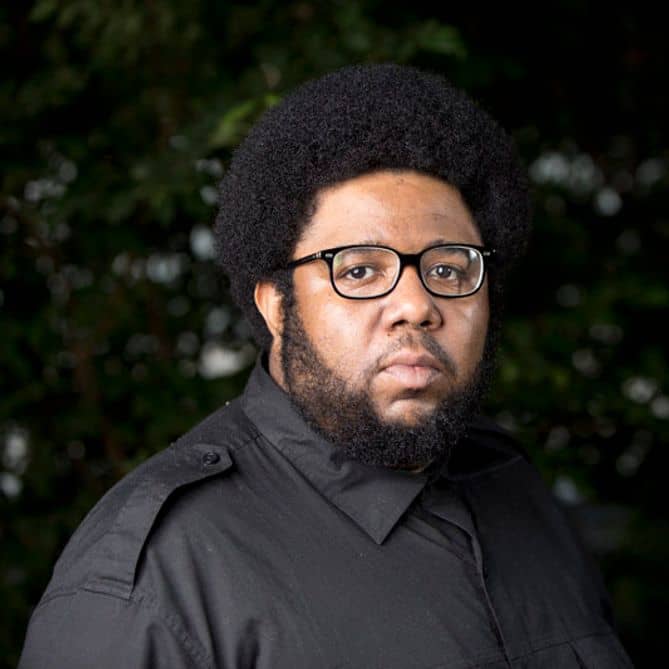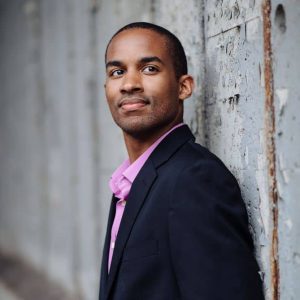
Tyshawn Sorey’s “Cycles of My Being”
Khari Joyner
Inhale, Exhale. Hope. Whirlwind. Hate. Hope. Each Day I Rise, I Know. These words represent not only a powerful and provocative landscape, but also uniquely form the six movements of Cycles of My Being; a work by the creative genius and living composer/musician Tyshawn Sorey. I had the immense honor and privilege of being invited to perform the 2018 world premiere of Sorey’s work— scored for violin, cello, piano, tenor, and clarinet—on three separate occasions. The piece was a result of a co-commission from Opera Philadelphia, Carnegie Hall, and Lyric Opera of Chicago; while the music was presented by Sorey, the libretto was provided by poet Terrance Hayes (also a MacArthur Genius Grant Winner like Sorey), with the renowned and arresting tenor Lawrence Brownlee at the forefront. What was perhaps most special about the work was its centerfold of one common experience that each of the musicians, all dear colleagues of mine (violinist Randall Goosby, pianist Kevin Miller, clarinetist Alex Laing, and tenor Brownlee) share—namely the experience of growing up as a black man in the USA.
I would be remiss to not speak about the living legend and mastermind of the work, Tyshawn Sorey. Growing up in Newark, NJ, Tyshawn quickly fell in love with music, specifically jazz, and often recounts to me his experiences improvising at the piano after school and even how he would practice drumming on “whatever he could get his hands on” at home. During his youth, he recognized a talent within himself, specifically on trombone, percussion, piano, but—especially after getting to know him—it would be hard for anyone to believe that he doesn’t possess savant-like qualities that in many ways could allow him to pick up ANY instrument and teach himself rather quickly. While he started his undergraduate studies as a jazz trombone major at William Paterson University in New Jersey, he soon after switched to jazz percussion and eventually studied composition at Wesleyan University in Middletown, CT with Anthony Braxton for his graduate studies. After many years of success/critical acclaim as a performer and completing his DMA in Composition at Columbia University, he would soon wind up as Assistant Professor of Music at Wesleyan, coming back full circle in a way. Perhaps one of his most notable accomplishments thereafter was being awarded a MacArthur Genius Grant in 2017, and he has recently been appointed as Assistant Professor of Music at University of Pennsylvania.
While I first met Tyshawn in 2018, at the first rehearsal of Cycles at the Kimmel Center in Philadelphia, I felt a visceral connection as if we had already been lifelong friends. We quickly discussed the nature of the piece and its intricately woven polyrhythms, dynamic contrasts, and sonic landscape. It was at the first rehearsal that I learned the motivation and story behind the work, from both Sorey and Larry Brownlee. We all were able to share our own experiences, as black men all born and raised in the U.S., but also the meaning behind each of the six movements.
The first, Inhale, Exhale, is a very contemplative but steady aria, where all five instruments weave in and out of the fabric that is created from the opening melody for the violin and piano. The second movement, Hope (Part I) is scored for trio—tenor, cello, and violin. While the text expresses the meaning of hope in a variety of contexts, what I find fascinating is the intense rhythmic triplets and later polyrhythms that underscore the movement. I can say from my own experience that this movement was probably the second most intense to put together as all instruments must navigate signatures 12/8, 15/8, 9/8, 11/8, and 13/8—to me highlighting both the text but also the rhythmic genius that is Tyshawn. Movement III, Whirlwind, is a very short and atonal aria for voice and piano, followed by an increasingly difficult movement for all instruments, Hate. This fourth movement was the longest and most difficult because of the nature of the highly technical writing for all voices, almost completely serial in nature. The fifth, Hope Part II, offers nothing but sonorous and lush harmonies for clarinet, piano, and tenor, and the final movement, Each Day I Rise, I Know is perhaps not only the most empowering, but also cyclically wraps the piece together as we play returning material from each of the previous movements.
The first performance of the piece I gave with the cast and Sorey conducting was the world premiere, to a sold out house at the Kimmel Center’s Perelman Theatre on February 20th, 2018. We received nothing but positive reception, and included an excellent panel discussion with the entire cast (including the librettist Hayes), moderated by Larry Brownlee. We went on to give the NY premiere on April 24th, 2018 at Carnegie’s Zankel Hall, to another sold out audience, and the most recent return of the work was again in Philadelphia but in September 2020. The entire cast and I agreed that, this most recent performance (which actually became a film adaption for a series that Opera Philadelphia TV hosted) was certainly the most poignant. We saw ourselves performing this work during a historical intersection in the U.S.A.—the COVID-19 pandemic and the racial unrest spawned from countless injustices to black and brown bodies at the Hands of law enforcement. Not only did we come together (albeit of course with the most stringent COVID-19 Health regulations and protocols for public safety) to perform this piece yet again, but coincidentally we found last fall to be the MOST relevant to our experiences black men in America than any other time preforming the work. We followed our performance with another panel discussion, and all agreed about the profundity of sarin tis work yet again with the world.
In conclusion, each of the three experiences performing Sorey’s work provided me a powerful impact in their own way. For me, I received just as much inspiration from playing the piece as I did working with each of my phenomenal colleagues. As someone like myself who champions the works of living composers, and ESPECIALLY those from underrepresented backgrounds, I cannot truly express ow proud and honored I was to be able to meet and perform the work of Tyshawn Sorey. I know that there will be many more experiences with the work and more to come, and certainly hope Tyshawn and other young voices of color will be able to flourish in the coming decades. And ultimately, I strive to inspire the future generation of performers to both champion these works but to also discover a new way of expressing their own identities in the most unapologetic and proud form possible.
Subjects: Repertoire
